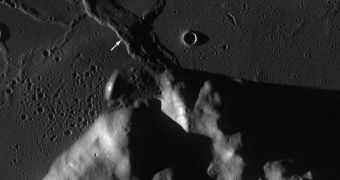While the Space Race was on between the Soviet Union and the United States, during the Cold War, Russians sent numerous landers on the Moon. Some of these machines, including the Luna 23 and Luna 24 spacecrafts, landed in a region called Mare Crisium, which is even today considered to be one of the most interesting places on our planet's natural satellite. It is considered to be very mysterious on account of the composition its soils have, as indicated by the 170 grams of materials that the Luna 24 sample-return mission brought back to Earth in 1976, Space Fellowship reports.
The puzzle related to Mare Crisium is more of a geological nature. The returned soil showed that the area featured a 1 percent concentration of titanium dioxide, which means that it is one of the poorest areas in the stuff on the surface of the Moon. Many sample-return missions, aimed at various regions of the satellite, returned soils that had considerably more titanium dioxide concentrations. This is very different from how things work on Earth. Here, chemical concentrations remain roughly the same throughout, whereas on the Moon they vary from 0 to 15 percent. Experts say that this is a huge range.
Given that we do not have the capabilities to support regular geological missions to the Moon, we must currently relay on remote sensing and studies to infer the makeup of the lunar soil. Geologists say that basaltic rocks which feature more titanium tend to absorb more light, whereas those with smaller concentrations reflect more photons. Absorption occurs both in visible and ultraviolet wavelengths, and researchers use advanced telescopes to investigate the differences, and establish which areas are the richest in which chemicals.
This type of investigation is extremely important for one simple reason. If and when astronauts return to the Moon, they will need to extract titanium for a wide variety of applications. Therefore, knowing where the largest concentrations are, and which regions are scarce in the chemical, could make all the difference. Permanent residents on the Moon will need to produce fuel, oxygen, water, and a host of metallic structures, directly on site, as carrying them from Earth would be prohibitively expensive.

 14 DAY TRIAL //
14 DAY TRIAL //